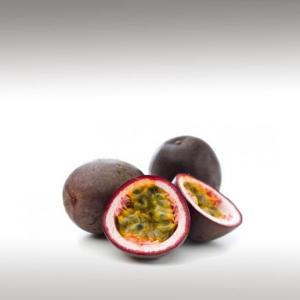
PASSION FRUIT SEED OIL (PASSIFLORA EDULIS) - BASE OILS

BASE / GENERAL DATA
Information submited: October 13, 2015 Modified: May 9, 2018 By: OperaDreamhouse
Passiflora Edulis is a vine species of passion flower that is native to Brazil, Paraguay and northern Argentina.
The name (Passiflora) was given by Spanish missionaries to South America as an expository aid while trying to convert the indigenous inhabitants to Christianity.
The Passion Fruit is a pepo, a type of berry, round to oval, either yellow or dark purple at maturity, with a soft to firm, juicy interior filled with numerous seeds.
The different flowering seasons of the purple and yellow Passion Fruits have been mentioned under "Pollination". In some areas, as in India, the vines bear throughout the year but peak periods are, first, August to December, and, second, March to May. At the latter time, the fruits are somewhat smaller, with less juice.
In Hawaii, passionfruits mature from June through January, with heaviest crops in July and August and October and November. With variations according to cultivar, and with commercial cultivation both above and below the Equator, there need never be a shortage of raw material for processing.
Another oil name is Maracuja oil. Maracuja oil comes from the Passion flower. Its biological name is Passiflora Incarnata. So, we see that both the sources are from the same genus.
Maracuja oil is a relatively expensive oil that comes from the various varieties of Passionflower plant. However, not all Maracuja oils come from this plant. Some of the Maracuja oils may be extracted from the seeds of Passion Fruit. Despite the differences in source, these two oils are quite similar. The oil is light and is considered to be a good emollient.
Chemical strucutre:
Passion Fruit oil is extracted from the seeds and composed mainly of linoleic acid (77%) with smaller amounts of oleic acid (15%) and palmitic acid (10%).
The oil showed high levels of unsaturated fatty acids (87,59%), including mainly linoleic (73,14%) and oleic (13,83%) acids, tocopherol (499,30 mg/kg) and phenolic compounds (1,314,13 mg GAE/kg).
Passion Fruit oil also contains ascorbic acid, β-carotene, calcium, flavanoids, phosphorus and potassium.
The colour of this oil is pale yellow to yellow / orange. The dark purple edulis variety is smaller than a Lemon, though it is less acidic than the yellow Passion Fruit, and has a richer aroma and flavour.
The name (Passiflora) was given by Spanish missionaries to South America as an expository aid while trying to convert the indigenous inhabitants to Christianity.
The Passion Fruit is a pepo, a type of berry, round to oval, either yellow or dark purple at maturity, with a soft to firm, juicy interior filled with numerous seeds.
The different flowering seasons of the purple and yellow Passion Fruits have been mentioned under "Pollination". In some areas, as in India, the vines bear throughout the year but peak periods are, first, August to December, and, second, March to May. At the latter time, the fruits are somewhat smaller, with less juice.
In Hawaii, passionfruits mature from June through January, with heaviest crops in July and August and October and November. With variations according to cultivar, and with commercial cultivation both above and below the Equator, there need never be a shortage of raw material for processing.
Another oil name is Maracuja oil. Maracuja oil comes from the Passion flower. Its biological name is Passiflora Incarnata. So, we see that both the sources are from the same genus.
Maracuja oil is a relatively expensive oil that comes from the various varieties of Passionflower plant. However, not all Maracuja oils come from this plant. Some of the Maracuja oils may be extracted from the seeds of Passion Fruit. Despite the differences in source, these two oils are quite similar. The oil is light and is considered to be a good emollient.
Chemical strucutre:
Passion Fruit oil is extracted from the seeds and composed mainly of linoleic acid (77%) with smaller amounts of oleic acid (15%) and palmitic acid (10%).
The oil showed high levels of unsaturated fatty acids (87,59%), including mainly linoleic (73,14%) and oleic (13,83%) acids, tocopherol (499,30 mg/kg) and phenolic compounds (1,314,13 mg GAE/kg).
Passion Fruit oil also contains ascorbic acid, β-carotene, calcium, flavanoids, phosphorus and potassium.
The colour of this oil is pale yellow to yellow / orange. The dark purple edulis variety is smaller than a Lemon, though it is less acidic than the yellow Passion Fruit, and has a richer aroma and flavour.

SPIRITUAL PRACTISES DATA

MEDICINE / HEALTH DATA

BEAUTY / COSMETICS DATA

FOOD / COOKING DATA
COMMENTS
No comments.


